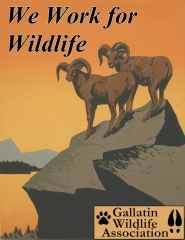To Contact Us, either contact us directly using this address or using the link button below.
Contact Details:
Gallatin Wildlife Association
P.O. Box 5317,
Bozeman, MT 59717
“To restore stability to our planet, therefore, we must restore its biodiversity, the very thing we have removed. It is the only way out of this crisis that we ourselves have created. We must rewild the world!”―David Attenborough


20191106.Addendum Comments on Moose - CGNF Draft Revised Forest Plan:
November 6, 2019
Forest Plan Revision Team
Gallatin National Forest All Units
P.O. Box 130, Bozeman, MT 59771
Gallatin Wildlife Association (GWA) in its persistence to advocate for wildlife and their respective habitat would like to include this additional reference and comment to those previously submitted by GWA on the Custer Gallatin National Forest Draft Revision Plan and the associated Draft Environmental Impact Statement. Original comments were submitted by GWA on June 1, 2019. GWA will continue to be engaged, bringing forth solutions to preserve the wildlands and wildlife of the Custer Gallatin National Forest (CGNF). We realize the formal comment period closed June 6, 2019, but also realize that the CGNF will accept public comments throughout this period of review. Specifically, we would like to augment our previously submitted comments on the matter of moose being considered as a Species of Conservation Concern. This addendum will provide additional information and reference in that regard highlighting the seriousness of that request and providing new scientific information supporting our claim to place moose on the list as a Species of Conservation Concern.
The Gallatin Wildlife Association would like to refer the Forest Plan Revision Team to the most recent article found in the Nov/Dec edition of Bugle Magazine by Heather Fraley. We have previously stated moose populations are facing unprecedented declines throughout the west, reasons not fully understood by scientists. However, this article highlights and confirms previous theories and concerns of GWA that the combination of parasites, disease, climate change and loss of habitat, the latter two bringing about changes in food supply are primary rationales for the declining population. As a result of these facts, Heather states the following in her article.
“State wildlife agencies cut moose hunting opportunity by 60 percent across former strongholds in Idaho, Montana, Wyoming and Utah from 2005 to 2015.”
This trend is verified by observations of researchers and agencies across the United States and Canada. These trends and theories were all part of discussions by Canada, the United States as well as European countries who attended an annual North American Moose Conference. Heather again states.
“What they saw was foreboding. Populations of the largest member of the deer family have declined over the last 30 years across much of their southern range in the United States and Canada.”
The title of this article is “Death By A Thousand Cuts, The Uncertain Future of Moose in Elk Country”. Toward the end of the article, Heather makes this statement.
“Nothing in wildlife has a single cause, and moose declines are no exception. Multiple factors interact differently in different habitats, but for all the uncertainty, managers are slowly getting a clearer picture of what’s happening with moose across elk country.”
Our question to the CGNF continues to be, what is being done by Forest Service researchers to understand population declines on the CGNF? The Custer Gallatin National Forest Draft Revision Plan and the associated Draft Environmental Impact Statement barely recognizes how stressors affecting moose populations on the CGNF. Knowing what we know and knowing what we don’t know, GWA would like a full accounting as to why these conditions don’t justify status of Species of Conservation Concern?
Again, please accept this reference and comment to those previously submitted. GWA would again like to thank the CGNF for receiving and considering the public’s input.
Sincerely,
Clint Nagel
Board Member for
Gallatin Wildlife Association